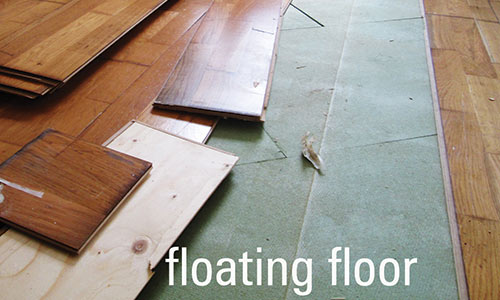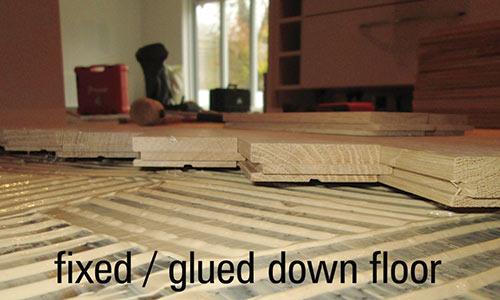Back to Wood Floor Fitting
Your Guide to Floating vs. Fixed Wood Floor Systems
Choosing the right wood flooring system for your home is an important decision that can significantly impact both the aesthetics and functionality of your space. Two of the most popular options are floating and fixed wood floor systems, each offering unique benefits and considerations. Floating floors, known for their easy installation and adaptability, provide a practical solution for various environments, especially in areas prone to moisture. On the other hand, fixed wood floors are celebrated for their stability and traditional appeal, making them a favourite among homeowners seeking a timeless aesthetic. In this guide, we will explore the features, advantages, and drawbacks of both systems, helping you determine which option best suits your needs and lifestyle. Whether you’re renovating an existing space or planning a new build, understanding these flooring systems will empower you to make an informed choice that enhances your home’s beauty and functionality.
Advantages and Disadvantages of Floating Floors

Floating installations are commonly used with engineered wood floors because solid wood cannot handle moisture or temperature changes well. Here’s a closer look at the advantages and disadvantages of floating floors:
Advantages of Floating Floors
-
Cost-Effective:
- Cheaper Installation: Engineered floors are generally less expensive than solid hardwood. The ease of installation means you can save on labour costs.
- DIY-Friendly: Modern click-and-lock systems make floating floors an easy DIY project, allowing homeowners to tackle the installation themselves.
-
Humidity Resistance:
- Floating floors are particularly suitable for areas with high humidity. A moisture barrier above your subfloor helps prevent potential water damage, making it ideal for basements and other moisture-prone areas.
-
Temperature Adaptability:
- Constant temperature changes have little effect on floating installations. They can expand and contract without the risk of cupping or bowing that solid wood experiences.
-
Versatile Installation:
- Floating floors can be installed almost anywhere, including over concrete, plywood, and sheet vinyl (not tile). This flexibility makes them a great option for various room types.
-
Comfort:
- These floors create an air cushion, making them comfortable to walk on, which can be especially appreciated in larger areas.
Disadvantages of Floating Floors
-
Wear and Tear:
- Floating floors can wear out faster than fixed installations. The slight bounce felt when walking can put pressure on the planks, potentially leading to a shorter lifespan.
-
Sound and Feel:
- Some homeowners find the hollow sound and sensation of walking on floating installations unsettling. The experience can vary significantly based on the quality of the material; a thicker engineered floor will feel different from a low-grade laminate.
-
Sanding Limitations:
- There’s a common misconception that floating floors cannot be sanded. While it’s true that most floating floors are engineered, whether they can be sanded depends on the thickness of the top layer. If it’s too thin, sanding is not possible.
- Additionally, sanding can be more challenging if the floating floor is laid over foam underlay. If your floor is over concrete, it can be sanded, but it’s advisable to consult a flooring expert for best results.
Overall, floating floors offer a range of advantages, especially for those seeking cost-effective and adaptable flooring solutions. However, it's essential to consider their potential drawbacks to ensure you make the best choice for your home.

Benefits and Downsides of Having a Fixed Floor
Fixed floors offer distinct advantages and disadvantages when compared to floating floors. Here’s an overview:
Benefits of Fixed Floors
-
Stability:
- Reduced Movement: Unlike floating floors, fixed installations do not shift or move. This stability means you won’t see your furniture moving when you walk on the floor, which can occur if a floating floor is not laid properly.
-
Sound and Feel:
- Solid Experience: Many people prefer the feel and sound of solid wood underfoot. Fixed floors provide a sturdy and reassuring sensation, eliminating the hollow sound associated with some floating installations.
-
Durability:
- Long-Lasting: Solid wood floors tend to be more durable over time, as they can withstand more wear and tear compared to floating options. With proper care, they can last for decades.
Downsides of Fixed Floors
-
Cost:
- Higher Price Tag: Fixed floors, typically made from solid wood, are generally more expensive than floating engineered alternatives. Additionally, the installation costs can be significantly higher.
-
Complex Installation:
- Professional Help Required: While installing a floating engineered floor can be a straightforward DIY project, glueing down a fixed floor is more complex. This task is best left to professionals who have the expertise and tools to ensure a proper installation.
-
Removal Challenges:
- Difficult to Remove: If you ever decide to remove your fixed floor, it can be a challenging process. Strong adhesives may pull pieces of the subfloor with them upon removal, necessitating a new leveling before installing new flooring.
While fixed floors offer unparalleled stability and a solid feel, they come with higher costs and installation complexities. Understanding the benefits and downsides will help you make an informed decision based on your specific needs and preferences.